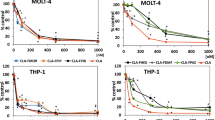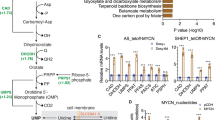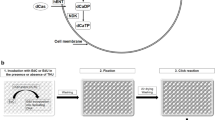Abstract
We have studied the growth inhibition, DNA synthesis inhibition and cell incorporation of the new anthracycline 4'-iodo-4'-deoxydoxorubicin (4'-iododoxorubicin) and of its 13-dihydroderivative in a model of doxorubicin-sensitive and -resistant rat C6 glioblastoma cells; results were compared to those obtained with doxorubicin and doxorubicinol in the same model. 4'-Iododoxorubicin was 7.5 times more potent than doxorubicin on the wild cell line and 45 times on the doxorubicin-resistant line, indicating that cross-resistance was only partial between the two drugs. Whereas doxorubicinol presented only a very faint cytotoxic activity, 4'-iododoxorubicinol retained the same activity as the parent drug against sensitive cells and a lower activity against resistant cells. DNA synthesis inhibition occurred for much higher doses than growth inhibition in the sensitive cells, but for similar doses in resistant cells. In both cell lines, 4'-iododoxorubicin and its metabolite were incorporated to a higher extent than doxorubicin and doxorubicinol respectively. Incorporation of metabolites was always lower than that of their parent compound. We have studied the metabolism of doxorubicin and 4'-iododoxorubicin by sensitive and resistant cells; only traces (less than 5%) of metabolites were identified in the cells as well as in the culture medium. A new cell line was selected for resistance in the presence of low amounts of 4'-iododoxorubicin. It presented a 6-fold resistance to 4'-iododoxorubicin and an 85-fold resistance to doxorubicin. Doxorubicin incorporation was markedly reduced in this cell line while 4'-iododoxorubicin was incorporated to the same extent as in the sensitive line. Measurements of drug efflux were performed in the three cell lines. No significant difference was exhibited between the efflux of doxorubicin and that of 4'-iododoxorubicin in each cell line; these effluxes were very rapid in the doxorubicin-selected resistant line, slow in the wild line and intermediate in the 4'-iododoxorubicin-selected line.
This is a preview of subscription content, access via your institution
Access options
Subscribe to this journal
Receive 24 print issues and online access
$259.00 per year
only $10.79 per issue
Buy this article
- Purchase on Springer Link
- Instant access to full article PDF
Prices may be subject to local taxes which are calculated during checkout
Similar content being viewed by others
Author information
Authors and Affiliations
Rights and permissions
About this article
Cite this article
Schott, B., Vrignaud, P., Ries, C. et al. Cellular pharmacology of 4'-iodo-4'-deoxydoxorubicin. Br J Cancer 61, 543–547 (1990). https://doi.org/10.1038/bjc.1990.122
Issue Date:
DOI: https://doi.org/10.1038/bjc.1990.122



